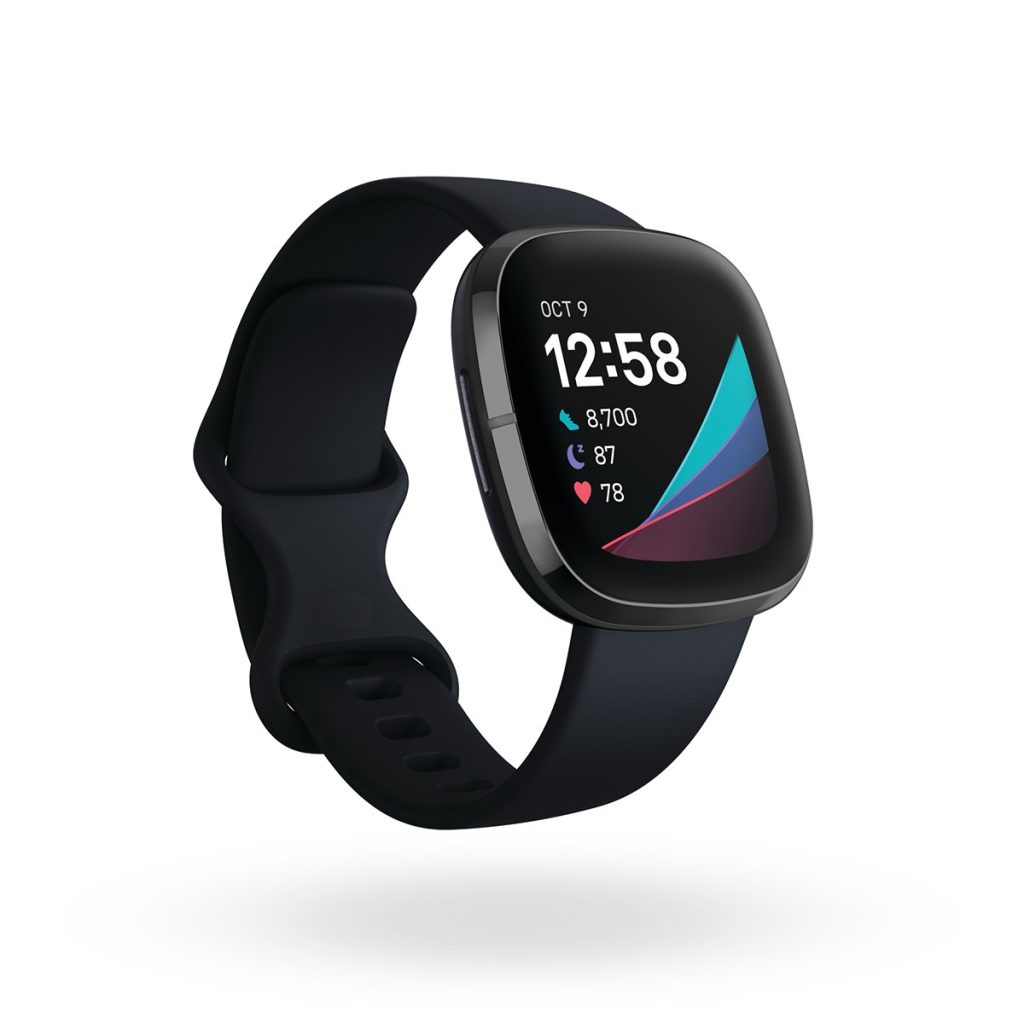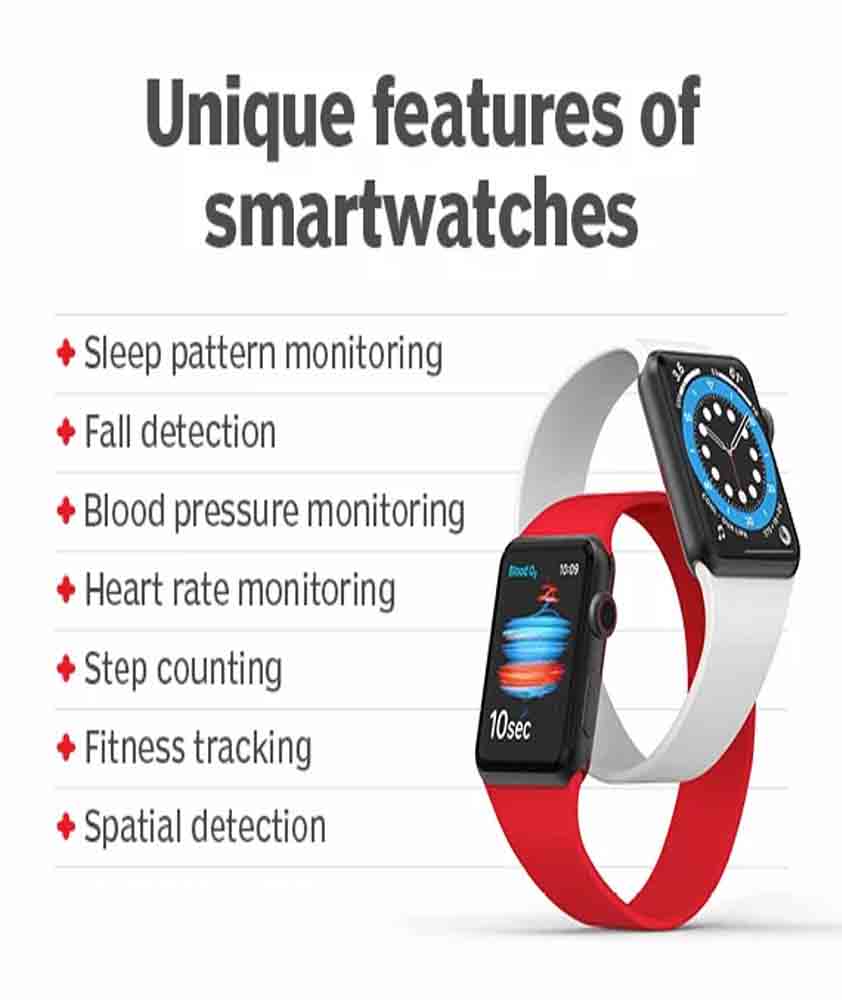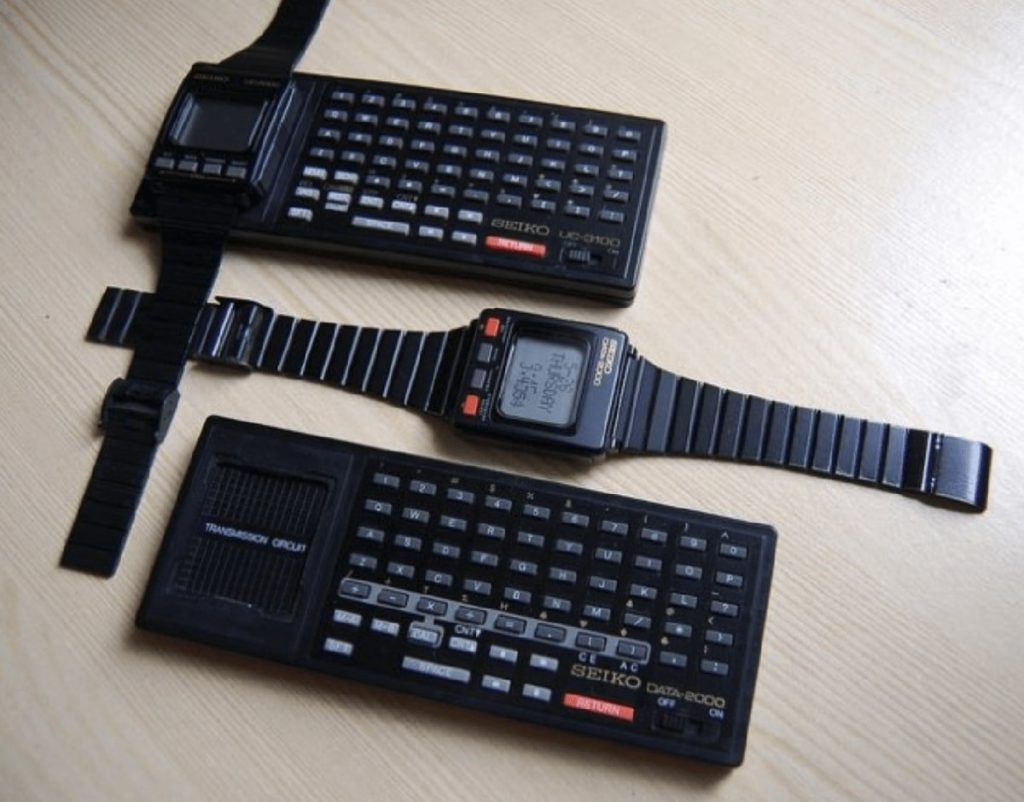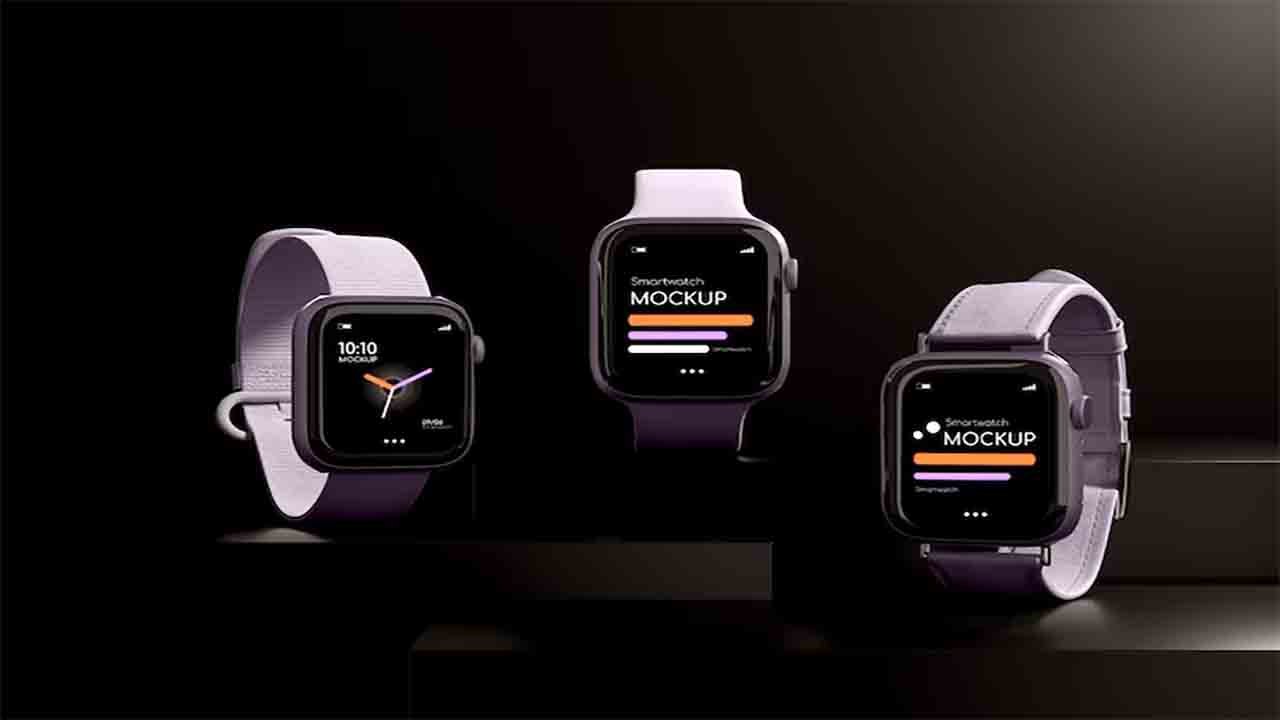A smartwatch is a wireless electronic device that can respond to spoken commands, by giving information or playing music. The smartwatch is just one example of wearable tech.
Introduction
A smartwatch is a wearable computing device that closely resembles a wristwatch or other time-keeping device.

In addition to telling time, many smartwatches are Bluetooth-capable. The watch becomes a wireless Bluetooth adaptor capable of extending the capabilities of the wearer’s smartphone to the watch. The wearer can use the watch’s interface to initiate and answer phone calls from their mobile phone, read email and text messages, get weather reports, listen to music, dictate email and text messages, and ask a digital assistant a question.
instance, some smartwatches collect data about the wearer’s health, monitoring the wearer’s heart rate, for instance. Others provide Global Positioning System (GPS) data, providing the wearer with walking or driving directions.
Smart tech
Smart devices and services are objects with computer systems embedded in them. They are usually connected to the internet and provide the user with enhanced functionality when compared to their non-smart counterparts. This extra ability to collect, process, and react to stimuli from the real world is what makes them smart.
The other part of what makes something smart is connectivity, both with the users and with other devices. Smart devices have heavily user-focused features and designs and take advantage of the other smart devices users have. So now you can use your watch to turn your lights on — what a time we live in!
What Do Smartwatches Do?
Most smartwatches—whether they’re intended for daily use (as with the Apple Watch) or for specific purposes (as with the Garmin Fenix)—offer a suite of standard features:
- Notifications: Smartphones display notifications to alert you of important events or activities. The types of notifications differ. Devices connected to a smartphone may simply mirror the phone’s notifications on your wrist, but other smartwatches display notifications that only a wearable can provide. For example, newer Apple Watches include a fall sensor. If you fall while wearing the watch, it senses your subsequent movement. If it doesn’t detect any movement, it sends a series of escalating notifications. Fail to respond to the notification, and the watch assumes you’re injured and alerts authorities on your behalf.
- Apps: Beyond displaying notifications from your phone, a smartwatch is only as good as the apps it supports. App ecosystems vary, and they’re tied to either Apple’s or Google’s environments. Smartwatches with a dedicated purpose, such as hiking or diving, generally support the apps they need to accomplish that purpose without the opportunity to add other kinds of apps.
- Media management: Most smartwatches paired with smartphones can manage media playback for you. For example, when you’re listening to music on an iPhone using Apple’s AirPods, you can use your Apple Watch to change the volume and tracks.
- Answer messages by voice: Remember the old Dick Tracy comics, where the hero detective used a watch as a phone? Modern smartwatches running either the watchOS or Wear operating systems support voice dictation.
- Fitness tracking: If you’re a hard-core athlete, a dedicated fitness band is likely a better choice than a smartwatch. Still, many smartwatches include a heart rate monitor and a pedometer to help track your workouts.
- GPS: Most smartwatches include a GPS for tracking your location or receiving location-specific alerts.
- Good battery life: Modern smartwatches feature batteries that get you through the day, with normal use, with a bit of juice still left to go. Battery use varies; the Apple Watch typically gets 18 hours of normal use on a single charge, while the Pebble gets two or three days.
The phone companion
There are also a lot of smartwatches that pair with your mobile phone and have feature sets that interact with the phone’s features.
They will include:
- Bluetooth
- Displaying and replying to messages
- Interaction with apps on your phone (e.g. skipping music tracks or checking emails)
- Voice control
- Notifications
These watches tend to share more design features with their phone counterparts than with each other. This being said they do have some common design features:
- Larger displays
- Bulkier housing
- Large range of colors
- Large range of straps
- More prominent buttons and controls
The most prominent smartwatch of this type would have to be the Apple Watch. It was one of the first internet-connected watches and is certainly the watch with the most mainstream popularity. The Apple Watch shares a visual style with the company’s line of iPhones, which had already become fashion items before the release of the watch.
What does this tell us about embedded systems?
Each of the types above has a specific type of user at its heart. Every design choice and component in them has been shaped by the needs of that user, or what the designers see as the needs of that user. These aren’t general-purpose devices; no one smartwatch will work for every user. To stand out and create successful devices, manufacturers will pick an audience and design the watch in a way that will appeal to them.
This isn’t just true of smartwatches; all embedded systems are user-driven. You won’t find open-ended features (things like disk drives or USB ports) that allow the users to change the functionality of the watches.
What unique features do smartwatches offer?
Smartwatches offer many features. Among them are the following:
- health informatics, such as heart rate, blood oxygen level, blood pressure, and temperature monitoring;
- contactless payment and digital wallet applications;
- messaging and calling features, similar to those on a smartphone;
- emergency calls for assistance if the watch detects the wearer has fallen;
- social media and other notifications from synchronized smartphone applications;
- games, music, photos, and other entertainment options;
- location features, such as maps, a compass, and an altimeter; and
- GPS tracking.

Smartwatches typically integrate with a user’s smartphone. Many of the same features and applications available on the phone are available on the watch and can synchronize with it. Apple Watch requires that users also have an Apple iPhone.
Some smartwatches have features for special uses. For example, police officers and firefighters might use a smartwatch application to receive alerts from dispatch. Pilots in the U.S. Air Force have smartwatches with special satellite navigation features.
Types of smartwatches
There are a number of general-purpose smartwatches on the market that provide a collection of features. Examples of these include the following:
- Apple Watch is Apple’s general-purpose smartwatch.
- Wear OS watches are available from multiple vendors that design and sell watches using Google’s Wear operating system (OS).
- Tizen watches use Samsung’s proprietary smartwatch OS.
There are also several smartwatch options available for specific uses, such as the following:
- Hiking and climbing. These watches are engineered for durability and are made to withstand drops, dust, and water. They also collect basic vital signs and can forecast the weather.
- Diving. These waterproof watches provide divers with important indicators such as depth, time remaining, and temperature.
- Aviation. Optimized for pilots, these watches have logbooks, GPS-powered maps, and weather tracking.
- Visual assistance. Braille watches enable visually impaired users to tell time and receive notifications.
Top smartwatch products
The following are some examples of prominent smartwatches:
- Apple Watch SE is a less expensive Apple Watch model.
- Apple Watch Series 7 is a general-purpose smartwatch with a QWERTY keyboard and a large display.
- Fitbit Sense includes a comprehensive set of health and wellness features.
- Fitbit Versa 3 comes with custom training programs, sleep analysis, and a fitness tracker.
- Garmin D2 Delta PX is a high-end, general-purpose watch with GPS flight navigation for aviators and health tracking features.
- Garmin Descent Mk2 Series is a specialty diving watch with Bluetooth.
- Garmin Vivoactive 4 has GPS, a built-in sports app, fitness tracking, and contactless payment features.
- Mobvoi TicWatch Pro 3 is a general-purpose smartwatch with 1 gigabyte of random access memory and sleep, heart rate, and fitness tracking.
- Motorola Moto 360 is a fitness tracking watch that is waterproof to 30 meters.
- Samsung Galaxy Watch4 is a general-purpose, Android-compatible smart digital watch with a rotating bezel.
- Suunto 9 Baro is a specialty hiking and outdoor sports watch.
Smartwatch Market Growth
Smartwatches settled into a steep growth curve in the late 2010s in terms of global market adoption. Data from Statista shows that sales rose from five million units worldwide in 2014 to an estimated 173 million in 2022. Apple’s market share rose from 13- to 30 percent from the second fiscal quarter of 2017 to the same period in 2021. Samsung is in the second-place spot with a 10-percent market share.

During the same period, specialty vendors like Garmin saw a 4.1-percent increase in year-over-year growth, while fitness-tracker-only vendors like Fitbit saw a nearly 22-percent market plunge.
Statista predicts that over 253 million smartwatches will ship worldwide by 2025.
History of smartwatches
Smartwatches can be traced back to the early 1970s. Hamilton Pulsar was one of the first digital watches, released in 1972. This marks the point in history when computers became small enough to fit in a wristwatch. Another early digital watch was the Calcron calculator watch, which featured a nine-digit display.
Another smartwatch predecessor was Seiko Data 2000, which came out in 1983. It could store two memos of 1,000 characters each and could be attached to a keyboard that came with the watch, which was used to type memos.

Seiko RC 1000 was released in 1984. It is connected to a personal computer. In 1990, Seiko released Receptor MessageWatch, a watch that received pager messages. Throughout the 1990s, wearable computers had increasingly complex data storage capabilities and battery lives.
Some of the first smartwatches were based on Microsoft’s Smart Personal Objects Technology (SPOT). Fossil and Suunto introduced the first SPOT watches in 2004. The watches were able to receive news, weather, and stock updates, as well as email and instant messages using frequency modulation transmitters.
Smartwatches gained popularity in the 2010s. Popular ones such as the Apple Watch — released in 2013 — began to take on a role in the mobile computing market. Google developed Android Wear, a mobile OS, in 2014.
For children and the elderly
In China, since around 2015, smartwatches have become widely used by schoolchildren. They are advertised on television throughout China as a safety device whereby the child can call in case of emergency. The devices are commonly colorful and made of plastic. They normally have no display unless a button is pushed. These smartwatches have limited functionality, mainly being able to conduct calls and display time, and sometimes air temperature. They cost around US$100 to $200.
Children’s smartwatches are also sold in other countries.
Some smartwatches can also help elderly or disabled people, reporting their location to a caretaker if they fall or become lost
Future of Smartwatches
Smartwatches have changed a lot in the last 50 years. They can now track, store and transmit complex data about the wearer.
One area that many smartwatch manufacturers are focusing on is biometric data. Smartwatches can monitor fitness information, like steps taken in the day and body composition. They can also monitor and spot potential medical conditions. Manufacturers are continually focusing on ways to include more health-related technologies in smartwatches.
The healthcare focus is in part related to the increase in chronic diseases that require constant monitoring. Smartwatches are helpful in this area. In addition, with their combined GPS, health, and portability features, smartwatches are useful for identifying exposure to COVID-19 and contact tracing.
With more real-time insight into a patient’s health data, doctors can provide more personalized care and identify illnesses before they get serious. Research and Markets predicted that the global wearables market will grow by 19.48% from 2021 to 2026.
There may be cybersecurity risks related to collecting health data from wearables. Learn what security administrators and healthcare organizations can do to protect sensitive health data gathered from wearable devices.
Computer – KnowledgeSthali
See This Also –
- What is Cloud Computing? Is cloud computing better? (1960-Present)
- Social Media (1973 – Today)
- Digital Marketing
- What is Cryptography?
- Conjunction: Definition, Types, 100+ Example
- Tense: Definition, Types, and 100+ Examples
- Punctuation: Definition, Rules, and 100+ Examples
- Direct and Indirect Speech: Rules, Charts, and 100+ Examples
- Syntax: Meaning, Definition, Rules, and 100+ Examples

